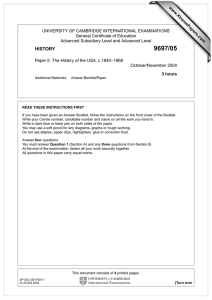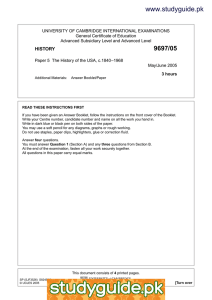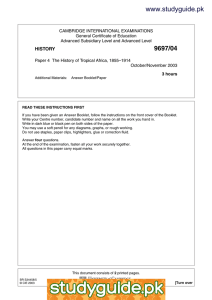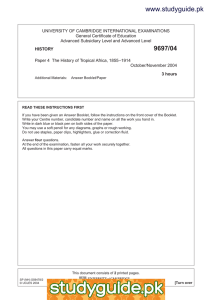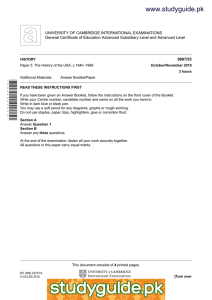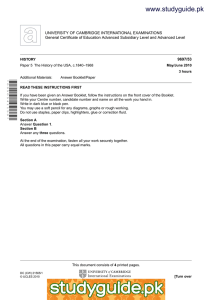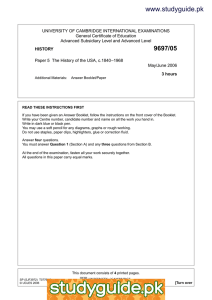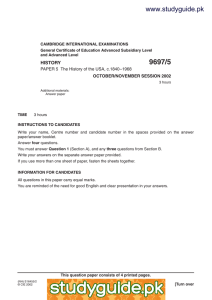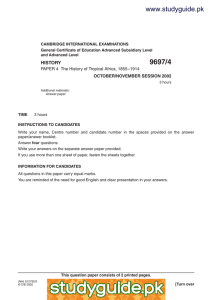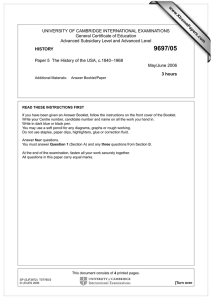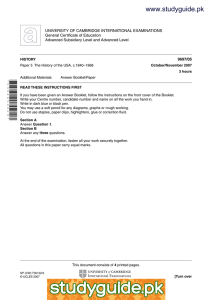www.studyguide.pk
advertisement
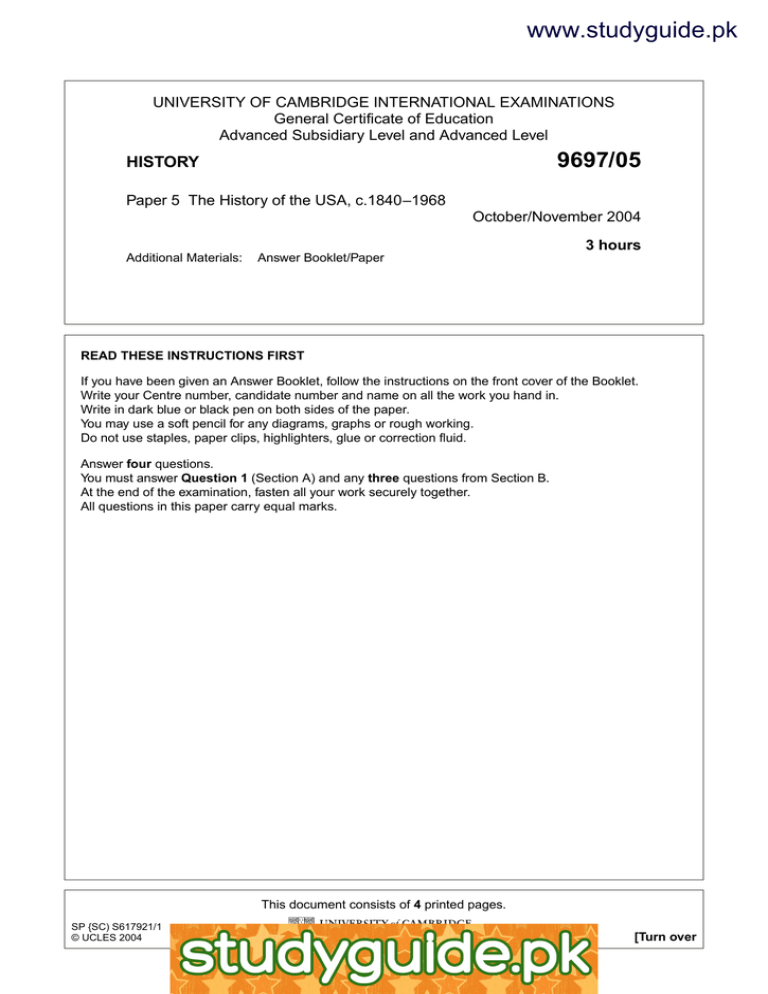
www.studyguide.pk
UNIVERSITY OF CAMBRIDGE INTERNATIONAL EXAMINATIONS
General Certificate of Education
Advanced Subsidiary Level and Advanced Level
9697/05
HISTORY
Paper 5 The History of the USA, c.1840–1968
October/November 2004
3 hours
Additional Materials:
Answer Booklet/Paper
READ THESE INSTRUCTIONS FIRST
If you have been given an Answer Booklet, follow the instructions on the front cover of the Booklet.
Write your Centre number, candidate number and name on all the work you hand in.
Write in dark blue or black pen on both sides of the paper.
You may use a soft pencil for any diagrams, graphs or rough working.
Do not use staples, paper clips, highlighters, glue or correction fluid.
Answer four questions.
You must answer Question 1 (Section A) and any three questions from Section B.
At the end of the examination, fasten all your work securely together.
All questions in this paper carry equal marks.
This document consists of 4 printed pages.
SP {SC) S617921/1
© UCLES 2004
[Turn over
www.xtremepapers.net
www.studyguide.pk
2
SECTION A: The Road to Secession and Civil War, 1846–61
You must answer Question 1.
THE ECONOMIC INTERPRETATION OF THE CIVIL WAR
1
Read the sources and then answer the question.
SOURCE A
You use slavery as a blind to delude the unwary. What do you propose, gentlemen of the Free-Soil
party? Do you propose to better the condition of the slaves? Not at all! You say you are opposed to the
expansion of slavery, but how are the slaves to benefit from this? It is not humanity which influences
you; it is so that you may have an opportunity of cheating us of our property. You want to limit slavery
so that you may have a majority in Congress and so convert the national government into an engine of
Northern aggression. Then you will be able to grow in prosperity upon wealth unjustly taken from the
South. You desire to weaken the power of the Southern states and why? Because you want by an
unjust system of legislation to promote the industry of New England at the expense of the people of the
South and their industry.
Jefferson Davis (later President of the Confederated States of America), speech to US Senate, 1856.
Source B
Our country is a theatre which exhibits in full operation two radically different political systems: the one
resting on the basis of servile labour, the other on the basis of voluntary labour of free men. Hitherto
the two systems have existed in different States, but side by side within the Union. These antagonistic
systems are continually coming into closer conflict, and collision results.
Shall I tell you what this collision means? They who think it is accidental, unnecessary, the work of
fanatical agitators, mistake the case altogether. It is an irrepressible conflict between opposing and
enduring forces, and it means that the United States must and will sooner or later become either
entirely a slave-holding nation or entirely a free-labour nation.
William H. Seward, speech at Rochester, New York, 25 October 1858.
Source C
The issue embraces more than the fate of these United States. It presents the question whether a
constitutional republic or democracy – a government of the people by the people – can or cannot
maintain its territorial integrity against its own domestic foes. It presents the question whether
discontented individuals, too few in number to control administration according to the Constitution, can
always, upon the pretences made here, or on any other pretences, or arbitrarily without any pretence,
break up their government, and thus practically put an end to free government upon the earth. It forces
us to ask: is there in all republics this inherent and fatal weakness? Must a government, of necessity,
be too strong for the liberties of its own people, or too weak to maintain its own existence?
It is now for the people to demonstrate to the world that those who can fairly carry an election can also
suppress a rebellion; that ballots are the rightful and peaceful successors of bullets; and that when
ballots have fairly and constitutionally decided, there can be no successful appeal back to bullets.
Abraham Lincoln, Message to the Special Session of Congress, 4 July 1861.
© UCLES 2004
9697/05/O/N/04
www.xtremepapers.net
www.studyguide.pk
3
Source D
The contest which ended in the War was indeed a contest between opposing principles, but not such
as bore upon the rights or wrongs of African slavery. They involved the very nature and structure of the
government itself. They were a contest between the supporters of a strictly Federal Government on the
one side and a thoroughly National one on the other.
Alexander H. Stephens (Vice-President of the Confederate States of America) in his memoirs, 1868 .
Source E
The Civil War was simply a conflict between two different systems of economic production to seize
control of the national government. The Northern capitalists wanted it to collect tariffs, build railroads,
shoot down workers, protect monopoly trusts, and in short to further the interest of their class. The
Southern slave owners wanted it to secure free trade, hunt down fugitive slaves, to conquer new
territory for cotton fields, and to maintain the supremacy of King Cotton. To say that the Civil War was
waged to abolish slavery is but to repeat a tale invented almost a decade after the war was ended as a
means of gratifying the party of capitalism, the Republican Party, and maintaining its supremacy.
An American historian’s analysis of the causes of the Civil War, 1906.
Now answer the following question.
‘The sectional conflict which led to the Civil War was about the clash of competing economic interests
and not the rights and wrongs of slavery.’ Using Sources A – E, discuss how far the evidence supports
this explanation of the causes of the Civil War.
© UCLES 2004
9697/05/O/N/04
www.xtremepapers.net
[Turn over
www.studyguide.pk
4
SECTION B
You must answer three questions from this section.
2
Why was it that the 1850 Compromise had started to unravel by 1856?
3
‘The victory of the Union in the Civil War was inevitable.’ How far do you agree with this view?
4
Evaluate the effectiveness of Progressivism on the United States politically, socially and
economically from 1901 to 1916.
5
Account for the dramatic rise and fall of the revived Ku Klux Klan in the 1920s.
6
Why was opposition to the New Deal so fierce?
7
To what extent were Roosevelt’s policies towards the ‘aggressor states’ between 1933 and 1941
weak and ineffective?
8
How far is it true to say that there was an ‘urban crisis’ in America by 1968?
© UCLES 2004
9697/05/O/N/04
www.xtremepapers.net
